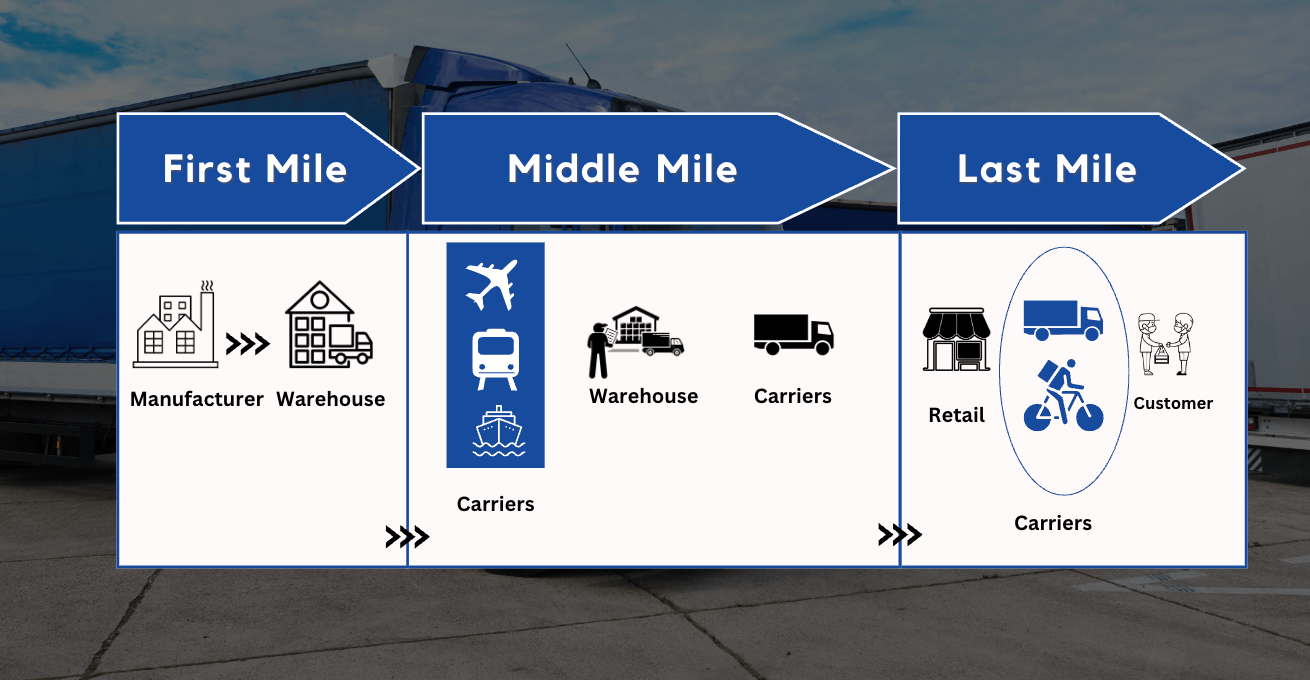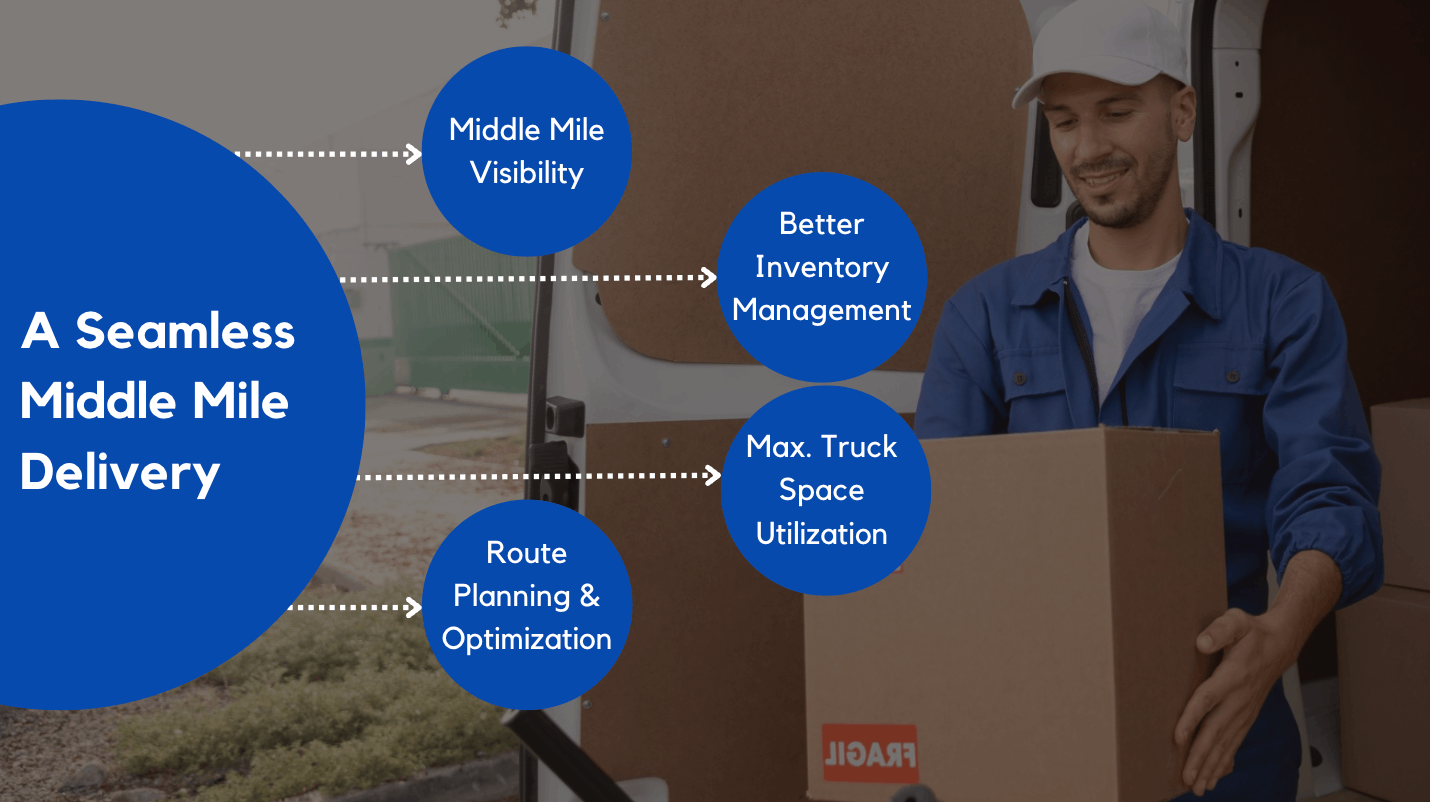Middle Mile Logistics: The Connecting Link For End-to-End Logistics
When discussing logistics, the focus is often on picking up the item from its origin, known as first mile or primary mile delivery. The other focus is on the final drop-off point, referred to as last mile delivery. However, in between these two legs comes the middle mile. The middle mile logistics is the process wherein the transfer of goods takes place between warehouse to warehouse, and warehouse to fulfillment center/ distribution center.
Sustainability, speed, and real-time communication have become key in this tech-based society. While most companies have moved their focus to last-mile delivery solutions, an efficient middle mile holds the key to ensuring maximum savings for your logistics operations. Industries such as CPG and retail can benefit a lot by improving their middle-mile logistics.
Benefits of Optimizing Middle Mile Delivery Movement:
Cost Optimization:
Being a fleet manager, one of the critical tasks is to optimize the logistics costs. The middle mile management offers good cost-cutting opportunities apart from first-mile and last-mile delivery operations. With the most optimized carrier selection, a fleet manager will have complete visibility of the movement of goods. This helps reduce routing and tracking efficiencies, helping improve profits for the business.
Capacity Utilization:
Efficient space utilization within the carrier is crucial to middle-mile logistics. Having a software solution that can place the items within the carrier as per the vehicle volume will hold the key. For loading and unloading goods at different temperatures, a multi-compartment vehicle is essential. LogiNext’s multi-compartment configuration feature supports hassle-free deliveries from the warehouse to stores.
Fast Deliveries:
The rise of on-demand services has led to the improvement of middle-mile logistics. For on-demand services, businesses generally utilize smaller vehicles for middle-mile delivery services. This helps in faster delivery times and gains a competitive edge in this competitive market. If several small packages each have a unique manifest ID, LogiNext generates a manifest ID for all of them. This allows scanning a single ID to track all smaller manifests efficiently. This will help in a faster delivery process for the middle mile segment.
Insights to Beat Competition:
Using an automation platform will help you with a quantum of data that you can use to enhance your middle-mile logistics. Making the middle mile automated and optimized in the best way allows businesses for healthier returns.

Why is hub load balancing the key to middle-mile success?
Hub load balancing involves segregating loads that need transport across multiple locations using a middle-mile logistics solution. This process helps prevent overloading, mis-delivery, and potential carrier vehicle breakdowns. LogiNext helps businesses to configure their branches/ hubs with the organization, shippers, and carriers. Some of the key parameters that should be considered to ensure seamless hub load balancing are as follows-
Client Name:
The selection of the client name that needs to be served from the specified branch needs to be addressed. One should also be able to set the shipper details if a shipper has to be addressed.
Branch Name:
Setting up branch names will ensure fleet managers get a clear view of all the branches. This will help during the middle mile logistics operations.
Geofencing:
Setting up a geofencing radius for middle-mile operations will ensure delivery associates serve orders within the set radius, offering real-time entry and exit alerts.
Branch Time zones:
Each branch will have a time zone for which the operations might take place. This will be crucial in ensuring the drivers are diverted to specific branches based on their time zones.
Shift Timings:
Branch managers can set up shift timings for which the deliveries have to be scheduled for pick-ups. Branch-level alerts would be sent via IVR, SMS, or email to respective branch managers as per the shift timings
Skill Sets:
Specifying the skill sets of a branch will help with faster and more efficient order fulfillment.
Branch Priority:
If there are multiple branches within a specified zone, you should be able to prioritize which branch the drivers should head out. This will help in improving the number of deliveries per day and save fuel idling.
Auto Assignments:
Last, but the important parameter is the use of auto-assignment. This can alert the driver about a specific branch for order fulfillment.
How to attain a seamless middle-mile to last-mile delivery?
Using a cloud-based automation platform will be the best way to move forward to resolve the obstacles related to middle-mile logistics.
Get Complete Visibility Over Middle Mile Logistics: Using transportation management software can help a business get control over their middle mile and last mile logistics. As fleet managers ensure optimal cost utilization for operations, having visibility and control over middle-mile logistics will give the best insights for reducing logistics operational costs. The use of technology will help create connectivity between truckers, warehouses/ stores, and everything in between for end-to-end communication and improved visibility, enhancing the overall logistics experience.
An Inventory Management System: LogiNext Haul can help prepare for tracking of items even before being loaded in the truck to maintain middle mile efficiency. With integration with WMS, one can easily track inventory and shipments. This will additionally help in forecasting when an item would be needed to be replenished to handle the surge in online order volumes.
Maximum Truck Space Utilization: Crate optimization and 3d packing optimization will help with efficient space utilization for middle-mile deliveries. These features will help with the pooling of goods and placing them in vehicles, based on the vehicle size. Differentiating goods to be transferred based on their size and volume and routing them based on customer priorities like time and cost will help improve the efficiency of middle-mile logistics operations.
Route Planning and Optimization: Selection of the best routes so that the trucks can reach warehouse locations at the right time will help improve the sustainability of your operations. Truck idling is a major pain point for middle-mile logistics, and with help of proper route planning and fleet optimization will ensure no waiting period. This way, fleet managers can help reduce fuel costs for warehouse-to-store distribution.

Conclusion:
Focusing on logistical optimization is the way to move forward to streamline your middle-mile logistics. Offering vehicles with the right capacity, better visibility, inventory management, and routing to the nearest sortation centers will easily reduce overall costs. LogiNext offers customers a one-stop solution offering flexibility, better communication, and shorter transit time that will help in faster deliveries and enhanced customer experience.
238








@LogiNext